Characteristics of Spatial and Temporal Evolution of Coastal Wetland Landscape Patterns and Prediction Analysis—A Case Study of Panjin Wetland, China
Abstract
1. Introduction
2. Materials and Methods
2.1. Study Area
2.2. Data Processing
2.3. Method
2.3.1. Landscape Dynamic Change Model
2.3.2. Landscape Transfer Matrix
2.3.3. Landscape Patterns Index
2.3.4. InVEST Model
2.3.5. PLUS Model
3. Results
3.1. Spatial and Temporal Changes in the Panjin Wetland
3.2. Analysis of the Changing Landscape Patterns in the Panjin Wetland
3.3. Driving Force Analysis and Multi-Scenario Modelling of Panjin Wetland Development
3.3.1. Natural Development Scenarios
3.3.2. Farmland Protection Scenarios
3.3.3. Ecological Protection Scenarios
3.3.4. Economic Development Scenarios
3.4. Habitat Quality
4. Discussion
5. Conclusions
Author Contributions
Funding
Data Availability Statement
Conflicts of Interest
References
- Pal, S.; Debanshi, S. Exploring the connection of physical habitat health of the wetland with its gas regulating services. Ecol. Inform. 2022, 69, 101686. [Google Scholar] [CrossRef]
- Qiu, P.H.; Zhong, Z.Q.; Gu, X.H.; Liu, Z.T.; Yang, X. Impact of regional wetland ecosystem structure and function changes on ecosystem service value:a case study of Haikou city. Plant Sci. J. 2022, 40, 472–483. [Google Scholar] [CrossRef]
- Li, Y.F.; Zhan, J.Y.; Liu, Y.; Zhang, F.; Zhang, M.L. Response of ecosystem services to land use and cover change: A case study in Chengdu City. Resour. Conserv. Recycl. 2018, 132, 291–300. [Google Scholar] [CrossRef]
- Shi, J.H.; Zhang, P.; Liu, Y.; Tian, L.; Cao, Y.Z.; Guo, Y.; Li, J.; Wang, Y.H.; Huang, J.H.; Jin, R.; et al. Study on spatiotemporal changes of wetlands based on PLS-SEM and PLUS model: The case of the Sanjiang Plain. Ecol. Indic. 2024, 169, 112812. [Google Scholar] [CrossRef]
- Munizaga, J.; Rojas, O.; Lagos, B.; Rojas, C.; Yépez, S.; Hernández, E.; Ureta, F.; De La Barrera, F.; Jato-Espino, D. Spatiotemporal vegetation dynamics in a highly urbanized Chilean coastal wetland: Insights on long-term natural and anthropogenic influences. Ecol. Indic. 2024, 169, 112919. [Google Scholar] [CrossRef]
- Quezada, C.R.; Diaz, S.; Munizaga, J. Urban fabric patterns on urban wetland. In Proceedings of the Green Urbanism Conference, Rome, Italy, 11 December 2019. [Google Scholar]
- He, J.H.; Pan, Y.; Liu, D.F. Analysis of the wetland ecological pattern in Wuhan City from the perspective of ecological network. Acta Ecol. Sin. 2020, 40, 3590–3601. [Google Scholar] [CrossRef]
- Tang, L.; Ma, W. Assessment and management of urbanization-induced ecological risks. Int. J. Sustain. Dev. World Ecol. 2018, 25, 383–386. [Google Scholar] [CrossRef]
- Singh, M.; Sinha, R. Hydrogeomorphic indicators of wetland health inferred from multi-temporal remote sensing data for a new Ramsar site (Kaabar Tal), India. Ecol. Indic. 2021, 127, 107739. [Google Scholar] [CrossRef]
- García-Ayllón, S. New strategies to improve co-management in enclosed Coastal Seas and Wetlands subjected to complex environments: Socio-economic analysis applied to an international recovery success case study after an environmental crisis. Sustainability 2019, 11, 1039. [Google Scholar] [CrossRef]
- Kim, B.; Lee, J.; Park, J. Role of small wetlands on the regime shift of ecological network in a wetlandscape. Environ. Res. Commun. 2022, 4, 041006. [Google Scholar] [CrossRef]
- Zhang, L.; Hou, G.; Li, F. Dynamics of landscape pattern and connectivity of wetlands in western Jilin Province, China. Environ. Dev. Sustain. 2020, 22, 2517–2528. [Google Scholar] [CrossRef]
- Xiong, Y.; Dai, Y.P.; Wu, H.P.; Liu, Y.Y.; Wang, G.Q.; Cai, X.X.; Zhou, L.; Zhou, N. Effects of extreme drought on landscape pattern of Dongting Lake wetland, China. Ecol. Indic. 2024, 169, 112974. [Google Scholar] [CrossRef]
- Zhao, C.; Gong, J.; Zeng, Q.; Yang, M.; Wang, Y. Landscape Pattern Evolution Processes and the Driving Forces in the Wetlands of Lake Baiyangdian. Sustainability 2021, 13, 9747. [Google Scholar] [CrossRef]
- Zhang, Y.; Niu, X.; Hu, Y.; Yan, H.; Zhen, L. Temporal and Spatial Evolution Characteristics and Its Driving Mechanism of Land Use/Land Cover Change in Laos from 2000 to 2020. Land 2022, 11, 1188. [Google Scholar] [CrossRef]
- Hou, M.; Ge, J.; Gao, J.; Meng, B.; Li, Y.; Yin, J.; Liu, J.; Feng, Q.; Liang, T. Ecological Risk Assessment and Impact Factor Analysis of Alpine Wetland Ecosystem Based on LUCC and Boosted Regression Tree on the Zoige Plateau, China. Remote Sens. 2020, 12, 368. [Google Scholar] [CrossRef]
- He, X.D.; Mai, X.M.; Shen, G.Q. Delineation of urban growth boundaries with SD and CLUE-S models under multi-scenarios in Cheng du Metropolitan Area. Sustainability 2019, 11, 5919. [Google Scholar] [CrossRef]
- Singh, S.K.; Mustak, S.; Srivastava, P.K.; Szabó, S.; Islam, T. Predicting spatial and decadal LULC changes through cellular automata Markov chain models using earth observation datasets and geo-information. Environ. Processes. 2015, 2, 61–78. [Google Scholar] [CrossRef]
- Peter, H.V.; Koen, P.O. Combining top-down and bottom-up dynamics in land use modeling: Exploring the future of abandoned farmlands in Europe with the Dyna-CLUE model. Landsc. Ecol. 2009, 24, 1167–1181. [Google Scholar] [CrossRef]
- Liang, X.; Guan, Q.; Clarke, K.C.; Liu, S.; Wang, B.; Yao, Y. Understanding the drivers of sustainable land expansion using a patch-generating simulation (PLUS) model: A case study in Wuhan, Computers, China. Environ. Urban Syst. 2021, 85, 101569. [Google Scholar] [CrossRef]
- Chen, L.T.; Cai, H.S.; Zhang, T.; Zhang, X.L.; Zeng, H. Land use multi-scenario simulation analysis of Ra River Basin based on Markov-FLUS model. J. Ecol. 2022, 42, 3947–3958. [Google Scholar] [CrossRef]
- Li, S.F.; Hong, Z.L.; Xue, X.P.; Zhang, F.J.; Shi, W. Multi-scenario simulation of LUCC in Binzhou City based on Logistic-CA-Markov coupled model. Soil Water Conserv. Res. 2022, 29, 292–299. [Google Scholar] [CrossRef]
- Wang, L.X.; Zhao, R.; Liu, Z.; Zhang, S.C.; Yang, Y. Monitoring and prediction of ecological environment quality in the Yanhe River Basin based on the remote sensing ecological index. AZR 2022, 39, 943–954. [Google Scholar] [CrossRef]
- Fan, W.J.; Dai, X.A.; Xie, Y.R.; Gao, Y.F. Prediction and analysis of land use change in sichuan province in the next 10 years based on CLUES model. Sci. Technol. Eng. 2022, 22, 2641–2647. [Google Scholar] [CrossRef]
- Peng, K.F.; Jiang, W.G.; Deng, Y.; Liu, Y.H.; Wu, Z.F.; Chen, Z. Simulating wetland changes under different scenarios based on integrating the random forest and CLUE-S models: A case study of Wuhan Urban Agglomeration. Ecol. Indic. 2020, 117, 106671. [Google Scholar] [CrossRef]
- Cuellar, Y.; Perez, L. Multitemporal modeling and simulation of the complex dynamics in urban wetlands: The case of Bogota, Colombia. Sci. Rep. 2023, 13, 9374. [Google Scholar] [CrossRef]
- Cuellar, Y.; Perez, L. Assessing the accuracy of sensitivity analysis: An application for a cellular automata model of Bogota’s urban wetland changes. Geocarto Int. 2023, 38, 2186491. [Google Scholar] [CrossRef]
- Zhou, C.X.; Meng, L.; Song, Y.C. Production and Dynamic Analysis of Panjin Wetland Project Map. GSIT 2021, 44, 300–304. [Google Scholar]
- Luo, K.Y.; Fan, Y.; Xia, H.l.; Song, X.A.; Song, Y.T. Changes and Driving Forces of Wetland Ecosystem Service Value in Panjin City. Wetl. Sci. Manag. 2023, 19, 45–49. [Google Scholar]
- Song, W.D.; Yang, D.; Li, E.B.; Zhao, Q.H.; Zhang, Y.N. Wetland information extraction and dynamic monitoring of Panjin. Sci. Surv. Mapp. 2016, 41, 60–65+79. [Google Scholar] [CrossRef]
- Jiang, T. Impact of economic development on the ecological environment of Panjin wetland. Mod. Agric. Sci. Technol. 2007, 22, 193–194. [Google Scholar] [CrossRef]
- Li, C.l.; Zhou, G.S.; Zhou, M.Z.; Zhou, L.; Liu, J. Net ecosystem productivity of Panjin reed wetland and its influencing factors from 1971 to 2020. CJAE 2023, 34, 1331–1340. [Google Scholar] [CrossRef]
- Chen, K.X.; Cong, P.F.; Qu, L.M.; Liang, S.X.; Sun, Z.C. Annual variation of the landscape pattern in the Liao River Delta wetland from 1976 to 2020. Ocean Coast. Manag. 2022, 224, 106175. [Google Scholar] [CrossRef]
- Xie, R.F.; Shen, Y.M.; Lao, H. Dynamic changes and responses of coastal wetland landscape pattern based on human disturbance degree in Yancheng, Jiangsu Province, China. Chin. J. Ecol. 2022, 41, 351–360. [Google Scholar] [CrossRef]
- Ding, H.M.; Yang, C.X.; Li, X.; Lu, Z.Q.; Zou, Y.Y. Evolution of Land Use Function and Its Ecological and Environmental Effects in Traditional Agricultural Areas of the Plateau. Res. Soil Water Conserv. 2022, 29, 399–407. [Google Scholar] [CrossRef]
- Zhou, K. Study on wetland landscape pattern evolution in the Dongping Lake. Appl. Water Sci. 2022, 12, 200. [Google Scholar] [CrossRef]
- Caro, C.; Marques, J.C.; Cunha, P.P.; Teixeira, Z. Ecosystem Services as a Resilience Descriptor in Habitat Risk Assessment Using the InVEST Model. Ecol. Indic. 2020, 115, 106426. [Google Scholar] [CrossRef]
- Gashaw, T.; Bantider, A.; Zeleke, G.; Alamirew, T.; Jemberu, W.; Worqlul, A.W.; Dile, Y.T.; Bewket, W.; Meshesha, D.T.; Adem, A.A.; et al. Evaluating InVEST Model for Estimating Soil Loss and Sediment Export in Data Scarce Regions of the Abbay (Upper Blue Nile) Basin: Implications for Land Managers. Environ. Chall. 2021, 5, 100381. [Google Scholar] [CrossRef]
- Yue, W.Z.; Xia, H.X.; Wu, T.; Xiong, J.H.; Zhong, P.Y.; Chen, Y. Spatial-temporal evolution of habitat quality and ecological red line assessment in Zhejiang Province. J. Ecol. 2022, 42, 6406–6417. [Google Scholar] [CrossRef]
- Liu, J.N.; Ji, G.X.; Gao, H.K.; Chen, W.Q.; Zhang, Y.L.; Huang, J.C.; Guo, Y.L.; Chen, Y.N. Multi-scenario Simulation and Eco-environmental Effect Analysis of Production-Living-Ecological Space in Henan Province Based on PLUS Model. Environ. Sci. 2024, 5, 1–15. [Google Scholar] [CrossRef]
- Ma, X.; Li, J.; Li, G. Simulation and multi-scenario prediction of land-use change in the Gansu section of the Yellow River Basin, China. Front. Environ. Sci. 2024, 12, 1403248. [Google Scholar] [CrossRef]
- Yang, J.; Xie, B.; Zhang, D.; Mak-Mensah, E.; Pei, T. Habitat quality assessment and multi-scenario prediction of the Gansu-Qinghai section of the Yellow River Basin based on the FLUS-InVEST model. Front. Ecol. Evol. 2023, 11, 1228558. [Google Scholar] [CrossRef]
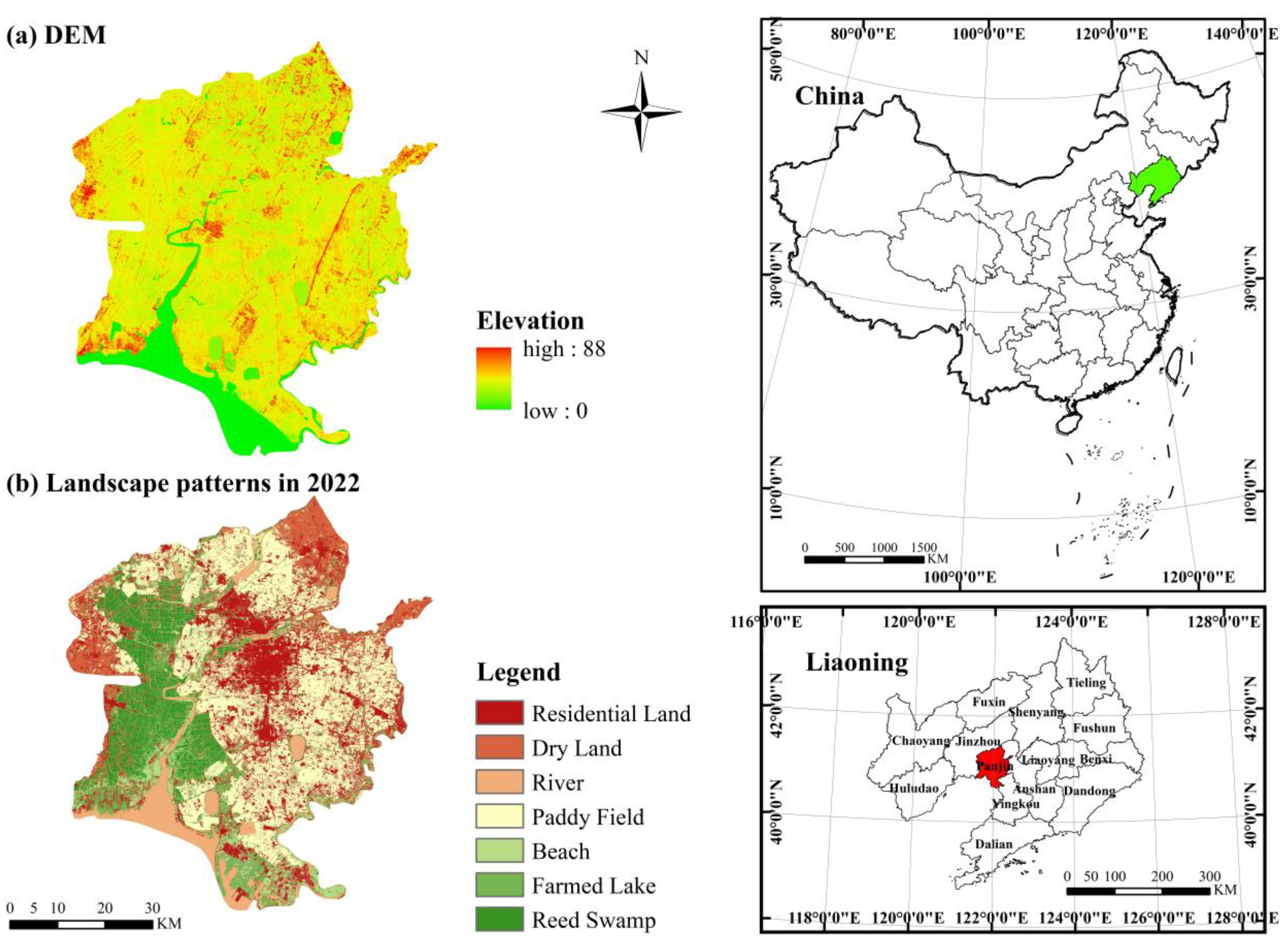

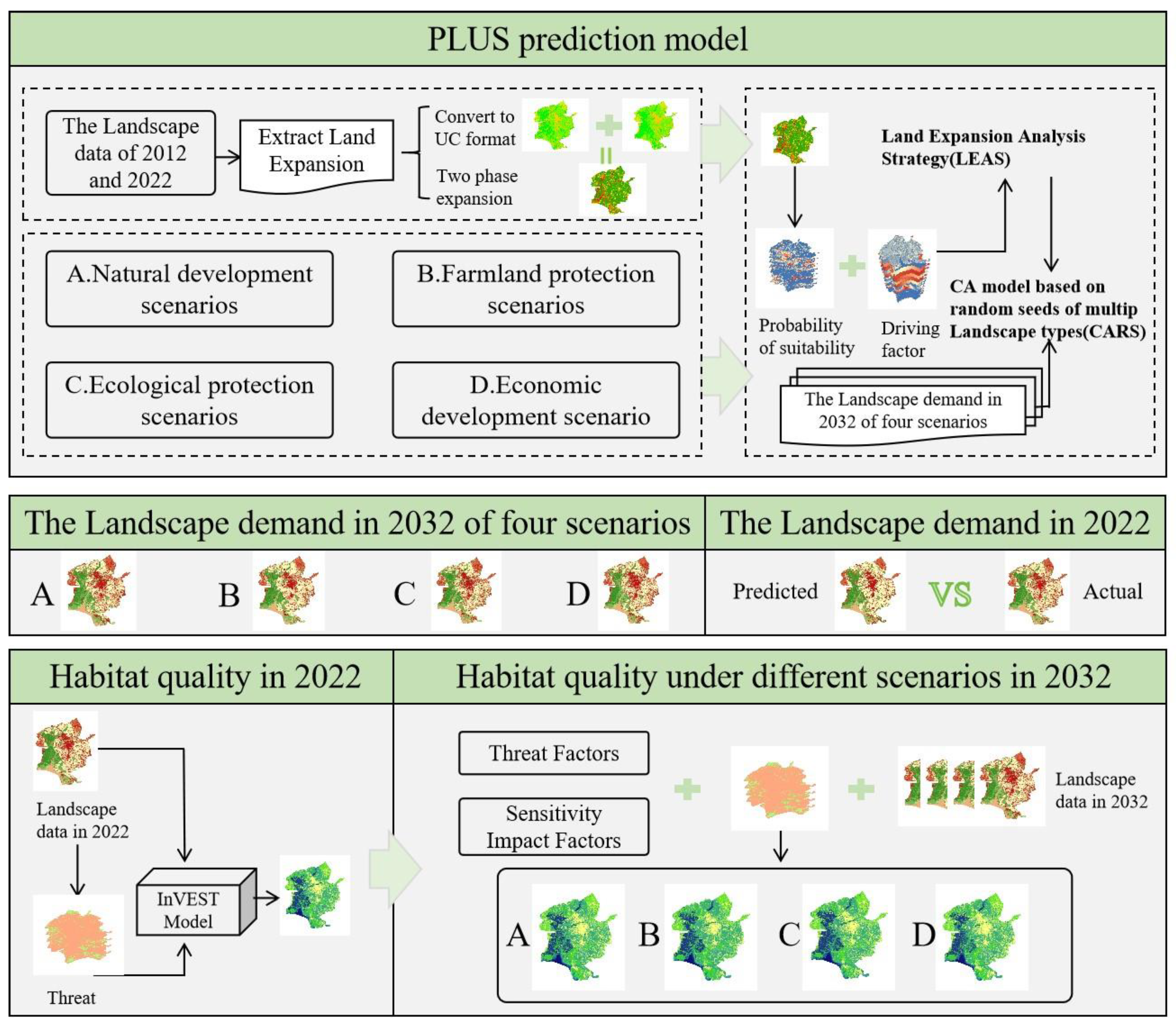
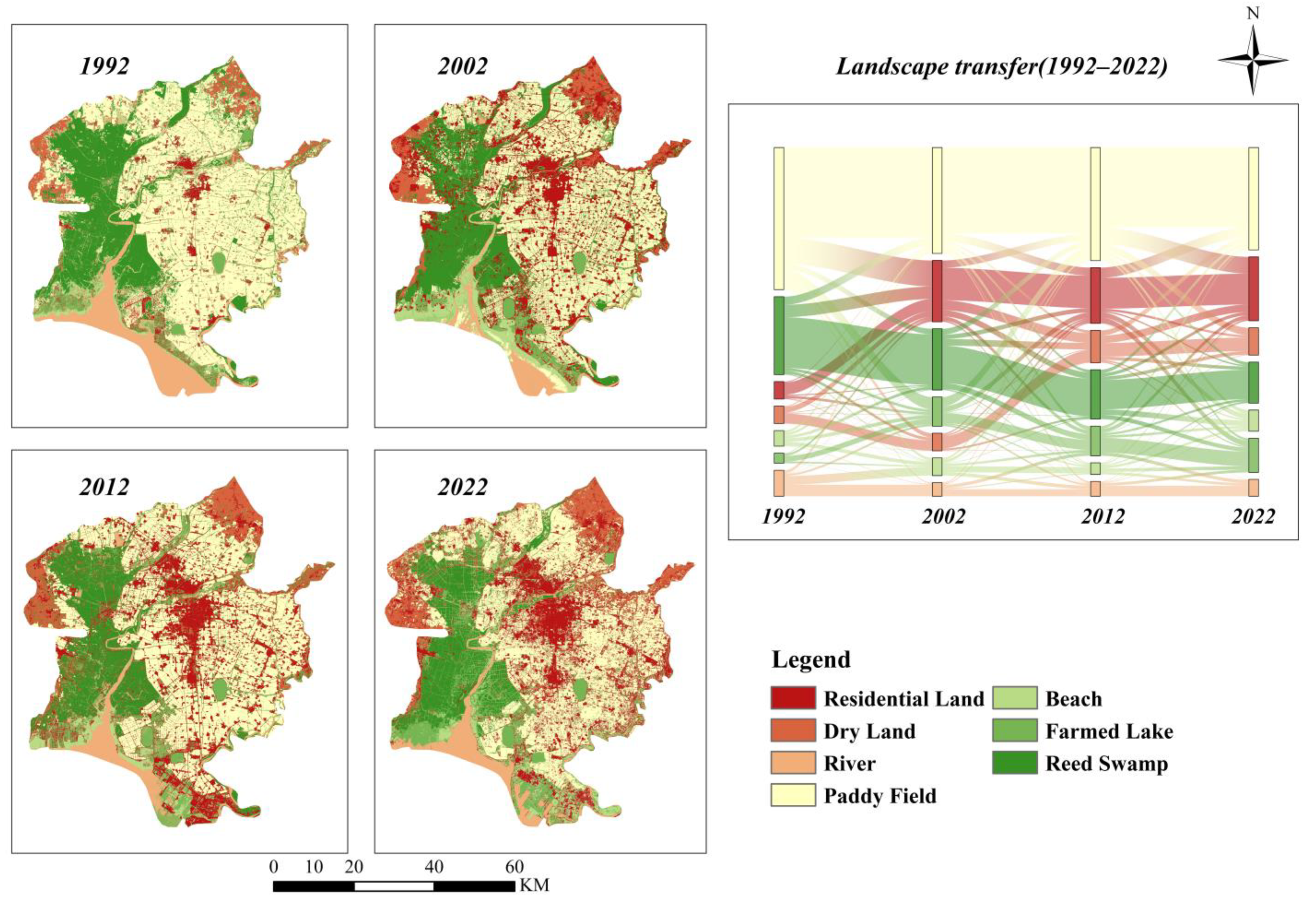
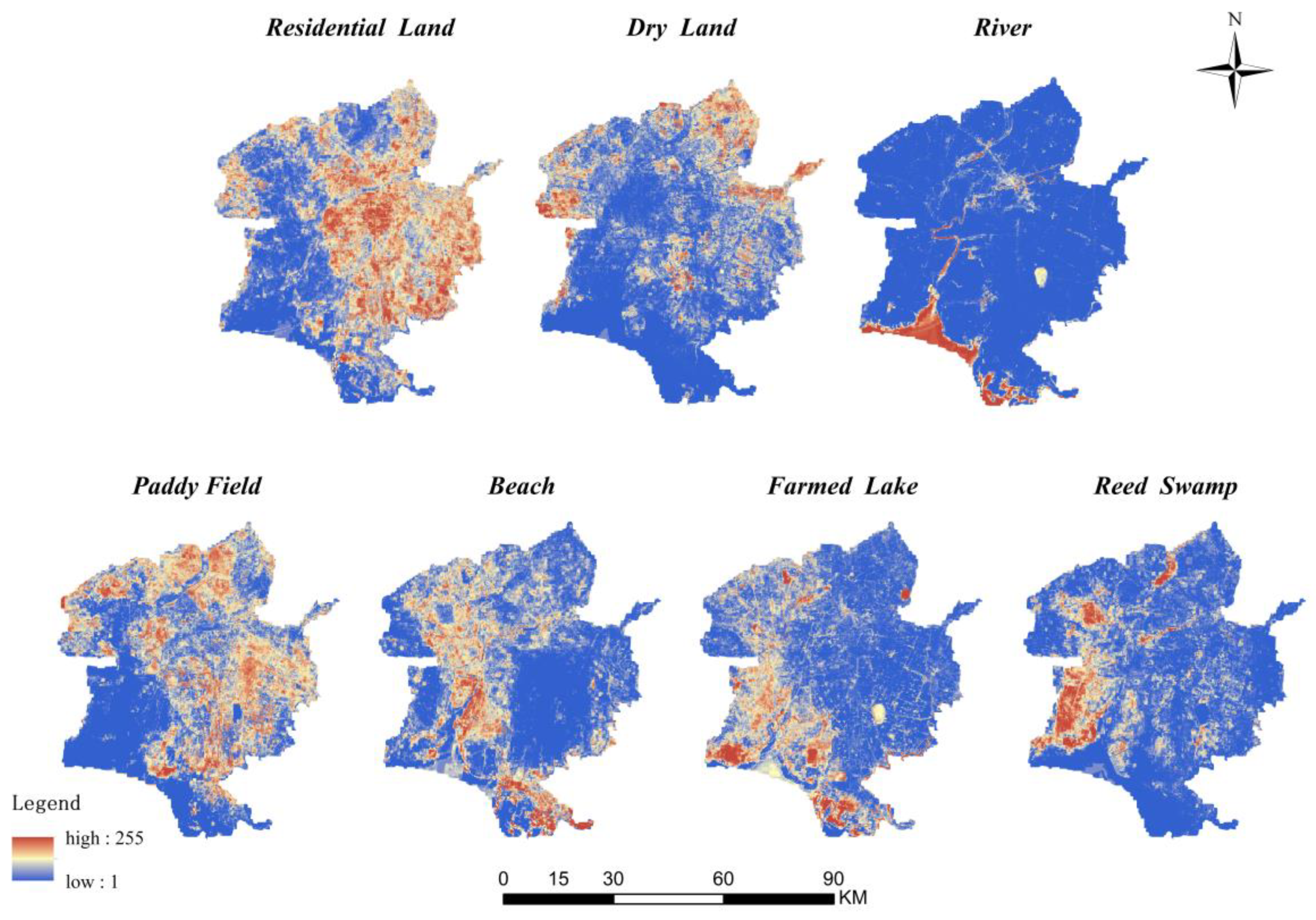

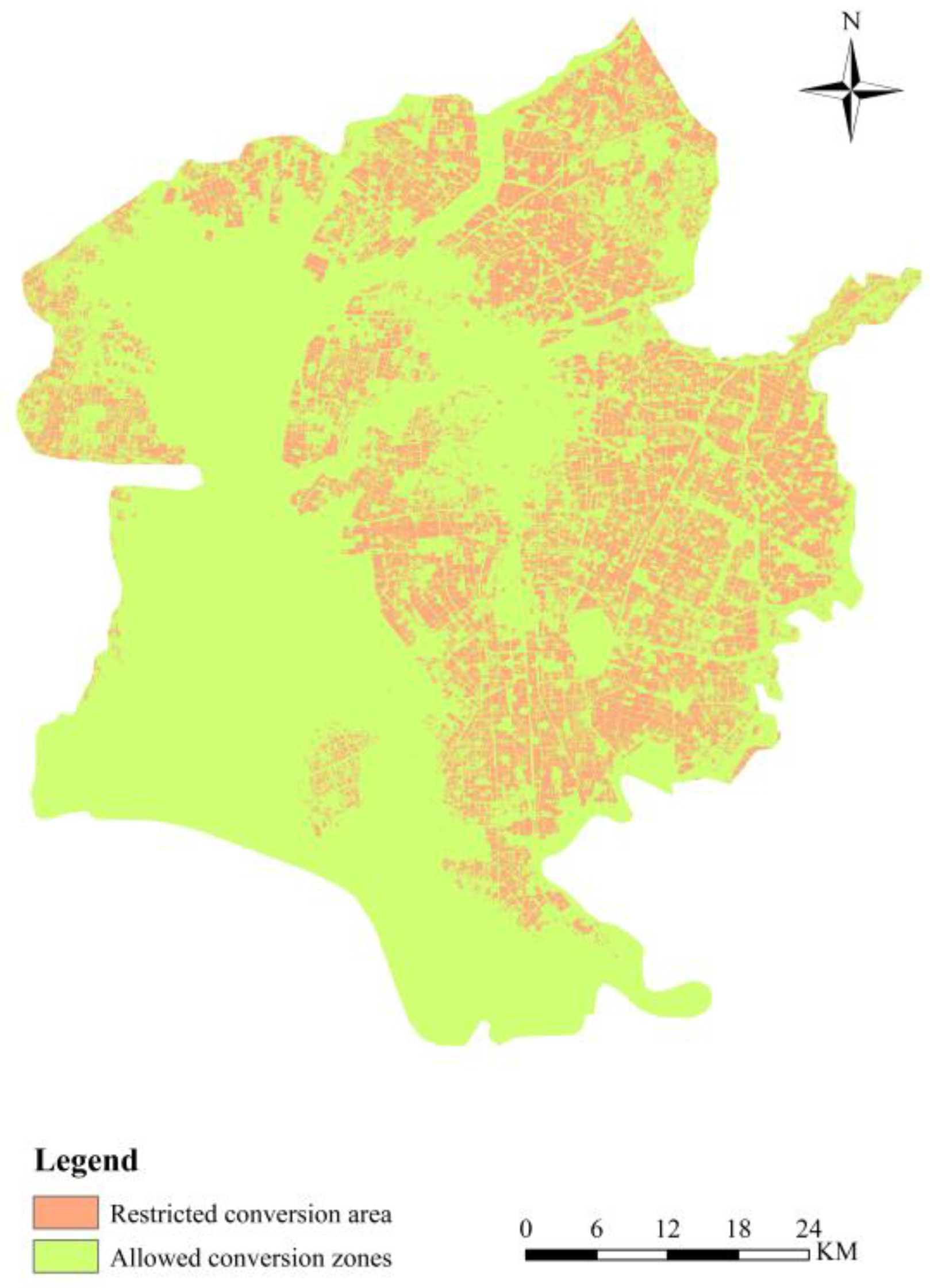


| Year | Satellite | Sensors | Date | Orbital No. | Cloud | Resolution |
|---|---|---|---|---|---|---|
| 1992 | Landsat 5 | TM | 10.2 | 120/31, 120/32 | 17.67 | 30 m |
| 2002 | Landsat 5 | TM | 9.14 | 120/31, 120/32 | 0.25, 0.48 | 30 m |
| 2012 | Landsat 7 | ETM+ | 8.16 | 120/31, 120/32 | 0.07, 0.05 | 30 m |
| 2022 | Landsat 8 | OLI | 2.25 | 120/31, 120/32 | 2.29, 0.57 | 30 m |
| Driving Factor | Spatial Resolution | Data Sources |
|---|---|---|
| Population (POP) | 1000 m | https://www.resdc.cn (accessed on 26 August 2024) |
| GDP | 1000 m | |
| Normalized difference vegetation index (NDVI) | 30 m | |
| Night lighting (NPP) | 30 m | |
| Average annual temperature (TEM) | 1000 m | |
| Average annual precipitation (PRE) | 1000 m | |
| Average annual ground temperature (GST) | 1000 m | |
| Average annual relative humidity (RHU) | 1000 m | |
| Annual sunshine duration (SSD) | 1000 m | |
| Elevation (DEM) | 30 m | http://www.dsac.cn (accessed on 26 August 2024) |
| Railroads | 300 m | https://www.webmap.cn (accessed on 26 August 2024) |
| River | 300 m |
| Year | Patch Density (PD) | Landscape Shape Index (LSI) | Landscape Pattern Index (LPI) | Shannon’s Diversity Index (SHDI) | Shannon’s Evenness Index (SHEI) | Aggregation Index (AI) |
|---|---|---|---|---|---|---|
| 1992 | 34.42 | 155.49 | 28.15 | 1.50 | 0.77 | 85.28 |
| 2002 | 41.72 | 189.08 | 10.16 | 1.70 | 0.87 | 82.07 |
| 2012 | 43.19 | 189.86 | 6.52 | 1.71 | 0.88 | 81.99 |
| 2022 | 39.28 | 211.71 | 14.13 | 1.77 | 0.91 | 80.00 |
| Year | Residential Land | Dry Land | River | Paddy Field | Beach | Farmed Lake | Reed Swamp |
|---|---|---|---|---|---|---|---|
| 2022 | 819.19 | 349.24 | 215.31 | 1307.48 | 269.82 | 435.95 | 523.54 |
| 2032 | 856.48 | 364.71 | 207.09 | 1232.91 | 289.78 | 499.90 | 469.65 |
| Year | Residential Land | Dry Land | River | Paddy Field | Beach | Farmed Lake | Reed Swamp |
|---|---|---|---|---|---|---|---|
| 2022 | 819.19 | 349.24 | 215.31 | 1307.48 | 269.82 | 435.95 | 523.54 |
| 2032 | 726.53 | 360.13 | 198.75 | 1368.07 | 299.85 | 479.62 | 487.58 |
| Habitat Quality | Natural Development Scenarios | Farmland Protection Scenarios | Ecological Protection Scenarios | Economic Development Scenarios | ||||
|---|---|---|---|---|---|---|---|---|
| Area/km2 | Percentage/% | Area/km2 | Percentage/% | Area/km2 | Percentage/% | Area/km2 | Percentage/% | |
| low | 850.74 | 22 | 716.71 | 18 | 828.21 | 21 | 934.82 | 24 |
| lower | 863.89 | 22 | 837.66 | 21 | 803.75 | 21 | 782.57 | 20 |
| medium | 1561.13 | 40 | 1706.19 | 44 | 1566.21 | 40 | 1603.44 | 41 |
| higher | 83.43 | 2 | 79.50 | 2 | 98.12 | 3 | 81.88 | 2 |
| high | 561.16 | 14 | 580.29 | 15 | 624.07 | 16 | 517.65 | 13 |
Disclaimer/Publisher’s Note: The statements, opinions and data contained in all publications are solely those of the individual author(s) and contributor(s) and not of MDPI and/or the editor(s). MDPI and/or the editor(s) disclaim responsibility for any injury to people or property resulting from any ideas, methods, instructions or products referred to in the content. |
© 2025 by the authors. Licensee MDPI, Basel, Switzerland. This article is an open access article distributed under the terms and conditions of the Creative Commons Attribution (CC BY) license (https://creativecommons.org/licenses/by/4.0/).
Share and Cite
Cheng, Q.; Chen, R.; Xu, W.; Wang, M. Characteristics of Spatial and Temporal Evolution of Coastal Wetland Landscape Patterns and Prediction Analysis—A Case Study of Panjin Wetland, China. Land 2025, 14, 118. https://doi.org/10.3390/land14010118
Cheng Q, Chen R, Xu W, Wang M. Characteristics of Spatial and Temporal Evolution of Coastal Wetland Landscape Patterns and Prediction Analysis—A Case Study of Panjin Wetland, China. Land. 2025; 14(1):118. https://doi.org/10.3390/land14010118
Chicago/Turabian StyleCheng, Qian, Ruixin Chen, Wei Xu, and Meiqing Wang. 2025. "Characteristics of Spatial and Temporal Evolution of Coastal Wetland Landscape Patterns and Prediction Analysis—A Case Study of Panjin Wetland, China" Land 14, no. 1: 118. https://doi.org/10.3390/land14010118
APA StyleCheng, Q., Chen, R., Xu, W., & Wang, M. (2025). Characteristics of Spatial and Temporal Evolution of Coastal Wetland Landscape Patterns and Prediction Analysis—A Case Study of Panjin Wetland, China. Land, 14(1), 118. https://doi.org/10.3390/land14010118





